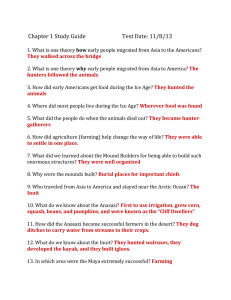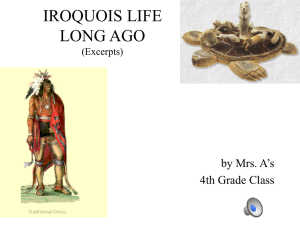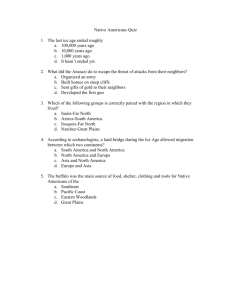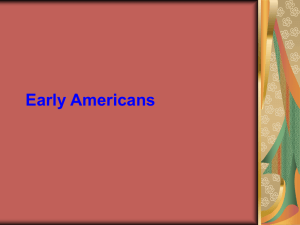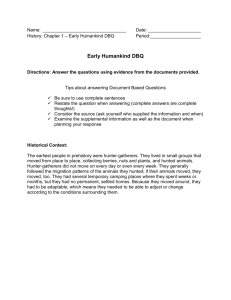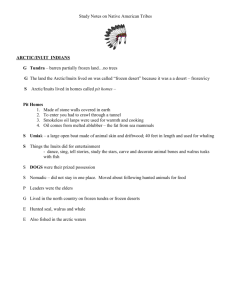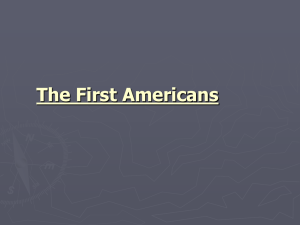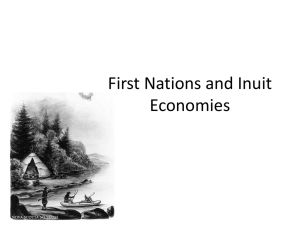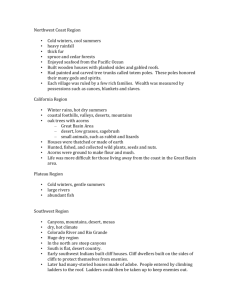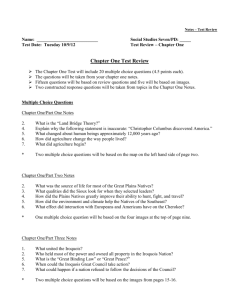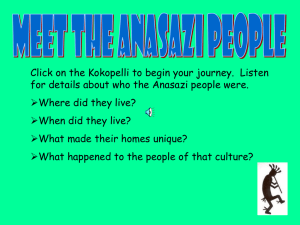Chapter 2 notes - Monmouth Regional High School
advertisement
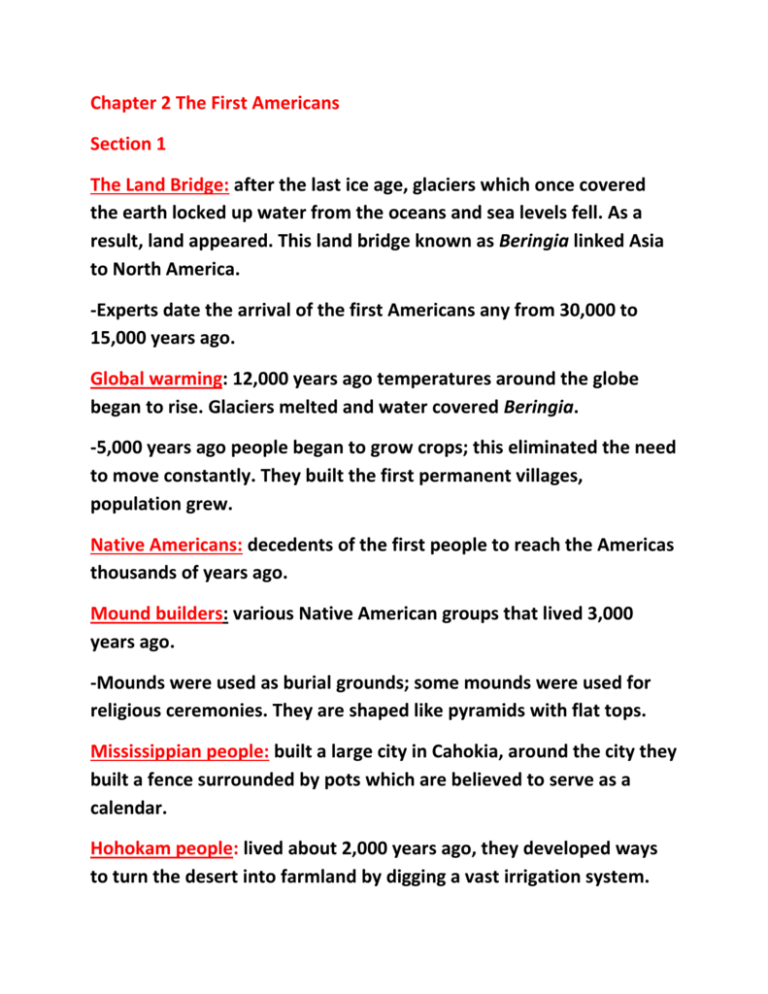
Chapter 2 The First Americans Section 1 The Land Bridge: after the last ice age, glaciers which once covered the earth locked up water from the oceans and sea levels fell. As a result, land appeared. This land bridge known as Beringia linked Asia to North America. -Experts date the arrival of the first Americans any from 30,000 to 15,000 years ago. Global warming: 12,000 years ago temperatures around the globe began to rise. Glaciers melted and water covered Beringia. -5,000 years ago people began to grow crops; this eliminated the need to move constantly. They built the first permanent villages, population grew. Native Americans: decedents of the first people to reach the Americas thousands of years ago. Mound builders: various Native American groups that lived 3,000 years ago. -Mounds were used as burial grounds; some mounds were used for religious ceremonies. They are shaped like pyramids with flat tops. Mississippian people: built a large city in Cahokia, around the city they built a fence surrounded by pots which are believed to serve as a calendar. Hohokam people: lived about 2,000 years ago, they developed ways to turn the desert into farmland by digging a vast irrigation system. Anasazi pueblos: they also farmed the desert by using irrigation. They also built large multistory houses made of stone and sundried bricks called adobe. -The Anasazi sought protection from warring neighbors by building adobe houses along cliffs. On the top of the cliff they planted crops. They built roads to connect to other villages. Section 2: 2 cultures: Arctic: Inuit people adapt to harsh climates, built igloos as shelter. Because of climate, in the winter the Inuit people set up camp by the sea to hunt for seal. In the spring they paddled Kayaks to spear seal, whale and walrus. In the summer they moved inland and hunted caribou. Inuit people believed each animal had a spirit and have thanks to the animal. Subarctic: people adapt to harsh climates, they moved from place to place and hunted moose & caribou. They supplied fur to traders. The Great Basin: lies in the dry intermountain region of the U.S. Few plants/ animals can survive. The Utes and Shoshones people who lived there spent most of their time looking for food. Plateau: people of the Plateau’s main source of food was fish, they hunted and gathered nuts, berries and roots. California: coastal people: fished Northern valley groups: hunted deer, rabbit, elk, collected berries and nuts. Pomos: skilled in weaving baskets and harvested nuts. Pueblos: “people of the southwest” decedents of the Anasazi. Buildings: adobes Food: grew corn, beans, squash Religion: reflected the importance of farming. Tried to please the spirits of nature, wind, rain and thunder. Villages: had a Kiva or underground chamber when religious ceremonies took place. Navajos: raided Pueblo fields for food, in time they accepted many Pueblo ways. They farmed and built Hogans (houses made of mud over wooden poles) they traded buffalo meat for corn and cloth. Plains People: built home of sod or matted grass and buffalo hides to made tepees. They farmed along the river and created tools made from animal bones. Natchez Society: hunted , fished and farmed along the Gulf Coast. Divided their year into 13 months (each named after a food/ animal) Religious beliefs: centered on the sun god. Natches leader: Great Sun Marriage: ensured membership in each class changed, this way no one can hold the title of the Great Sun forever. Iroquois: called themselves House Builders. Woman owned all the property in the long house and were in charge of harvesting crops. Women also had political power because they chose the sachem (tribal chiefs.) Iroquois included 5 nations: Mohawk, Seneca, Onondaga, Oneida, Cayuga. -Each had its own ruling council and fought constantly. A league of Iroquois was developed to put an end to the warfare. Later, a 6th nation the Tuscarora joined the league. -Southeast was home to more Native Americans than any other region, men and women had defined roles. Section 3: The Mayas: Flourished from 300- 900 A.D. -Created the most advanced early civilization in the Americas. -Built religious centers such as the Palenque, Uxmal, Tikal and Copan. -Excelled at math and astronomy. They understood the concept of zero and had a symbol for it. -Their calendar was the most accurate and they developed a written language. The Aztecs: Capital is Tenochititlan. -Their strong army and well organized government allowed them to extend their power. -Aztecs collected tribute in the form of gold,. Cotton, turquoise, feathers, incense, food and humans. (sun god was fed through human hearts and blood) -Successful in agriculture and trade. The Incas: Beginning in the early 1400’s, they dominated the Pacific Coast and South America. Capital: Cuzco ( high Andes Mountains) Built a road system stretching 2, 500 miles. Runners: memorized messages and carried them from place to place. Quipu: tied strings with knots of different colors. Each represented information and financial accounts. -Made great advances in agriculture and medicine. Section 4: Viking Voyages: seafaring people from Scandinavia. In 1001 they briefly settled in North America (Canada). The Viking name came from the Inuits. Christopher Columbus: Spanish explorer from Spain sailed into the Caribbean Sea in 1492. He first landed on a small Caribbean island called Tainos. They claimed the land and forced the Native Americans to work in gold mines, ranches or Spanish households. Within 100 years, the Taino population died. Columbian Exchange: the exchange between Native Americans and Europeans exchanged medicine, technology, government, arts, language, and culture. -Native Americans died of European diseases.
